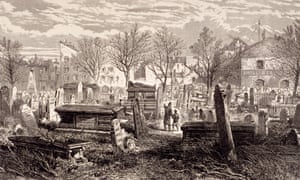"I have seen them play at what is called skittles; put up bones and take skulls and knock them down; stick up bones in the ground and throw a skull at them and as you would a skittle-ball." http://www.theguardian.com/cities/2015/jan/22/death-city-grisly-secrets-victorian-london-dead
While London secrets were full of horse manure during the 1800's, London cemeteries were full of rotting corpses. With cholera epidemics in 1832, 1854 and 1866, Londoners were dying at a rapid rate, but the graveyards did not have the capacity to bury them all. Coffins were stacked one on top of the other, sometimes as many as 10, in 20 foot deep shafts, leaving mere inches between the top corpse and the graveyard surface. As the bodies decomposed, they let off a putrid scent which, some believe, made people sick, a problem called "miasma".
The graveyards, not under any restrictions, were a free-for-all for gravediggers. Corpses were disturbed, dismembered or destroyed to make room for new ones. Disinterred bones, dropped by neglectful gravediggers, lay scattered among the tombstones. Smashed coffins were sold to London's poor for firewood. Mr. Jones at New Bunhill Cemetery was caught taking down tombstones and monuments and "selling them for whatever he could get". One Londoner explained the macabre scene he witnessed:
"I saw them chopping the head of his coffin away; I should not have known it if I had not seen the head with the teeth; I knew him by his teeth; one tooth was knocked out and the other splintered; I knew it was my father's head, and I told them to stop, and they laughed..."
London's poor were at the mercy of the gravediggers. For the middle and upper class, however, the solution came with garden cemeteries built outside the city limits. The following cemeteries were built to alleviate the overcrowding problem: Kensall Green (1832), West Norwood (1836), Highgate (1839), Abney Park (1840), Nunhead (1840), Brompton (1840), and Tower Hamlets (1841).

Note: For more information read Dirty Old London by Lee Jackson.
No comments:
Post a Comment